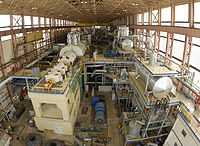Kola Nuclear Power Plant
| Kola Nuclear Power Plant | |
|---|---|
 Kola Nuclear Power Plant | |
| Country | Russia |
| Coordinates | 67°28′N 32°28′E / 67.467°N 32.467°ECoordinates: 67°28′N 32°28′E / 67.467°N 32.467°E |
| Status | Operational |
| Construction began | 1970 |
| Commission date | 28 December 1973 |
| Operator(s) | Energoatom |
| Power generation | |
| Units operational | 4 x 440 MW |
| Annual generation | 9,846 GWh |
The Kola Nuclear Power Plant (Russian: Кольская АЭС [![]() pronunciation ]), also known as Kolsk NPP or Kolskaya NPP, is a nuclear power plant in Murmansk Oblast in north-western Russia.
pronunciation ]), also known as Kolsk NPP or Kolskaya NPP, is a nuclear power plant in Murmansk Oblast in north-western Russia.
History


The Phase 1 (No. 1 and 2 reactors) at the Kola NPP went online in 1973 and 1974, respectively, and are part of Russia’s first generation of PWR reactors (the VVER 440/230 type). The Phase 2 (No. 3 and 4 reactors) went online in 1981 and 1984 with the improved VVER 440/213 type.
Phase 1 reactors were designed to work for 30 years and were originally slated to be shut down in 2003 and 2004. However the shutdown did not happen. Instead, the operational life spans of the reactors were extended, after a massive safety upgrade effort that included about 200 safety systems upgrade projects[1] and was financed in part by the governments of Norway, Sweden, Finland and USA.[2][3]
Today
Kola NPP produces about half of Murmansk Oblast's energy. It is of a type similar reactor to Finland's Loviisa Nuclear Power Plant, which conforms to regulatory requirements commonly considered to be the most stringent in the world.
Reactor data
The Kola Nuclear Power Plant has four units:
| style="width=21%; | Unit[4] | Reactor type | Net capacity |
Gross capacity |
Construction started |
Electricity Grid |
Commercial Operation |
Shutdown |
|---|---|---|---|---|---|---|---|
| Kola-1 | VVER-440/230 | 411 MW | 440 MW | 18.05.1969 | 29.06.1973 | 28.12.1973 | 2018 |
| Kola-2 | VVER-440/230 | 411 MW | 440 MW | 15.05.1969 | 08.12.1974 | 21.02.1975 | 2019 |
| Kola-3 | VVER-440/213 | 411 MW | 440 MW | 01.04.1977 | 24.03.1981 | 03.12.1982 | 2026[5] |
| Kola-4 | VVER-440/213 | 411 MW | 440 MW | 01.08.1976 | 11.10.1984 | 06.12.1984 | 2029[5] |
Campaign to close the station

Several environment movement groups such as the ecologists from Norway and Russia support media campaign to close Kola NPP citing safety concerns with Phase 1 reactors and alleged violations of Russian law during issue of operating permit extensions.
The license for phase 1 reactors five-year operation extensions, granted by the Russian Federation's civilian nuclear regulator Gosatomnadzor (FSETAN’s predecessor), were issued without conducting an obligatory state environmental impact study. Conducting such federal level studies is mandated by the law "On Environmental Impact Studies" in Article 11.
The first extension for the old reactors was issued in summer 2003, almost precisely after former Deputy Minister of Atomic Energy Andrei Malyshev was installed as Gosatomnadzor’s chief. He replaced Yury Vishnevsky at this post. Vishnevsky had been an outspoken critic of the former Ministry of Atomic Energy, now known as the Federal Agency for Atomic energy, or Rosatom.
In April 2005, the Murmansk Regional Prosecutor issued a recommendation to resolve the violations surrounding the reactor life-span extensions and force regulatory bodies and Rosenergoatom, Russian's nuclear power plant operations conglomerate, to carry out the environmental impact studies. But none of this took place.
The Murmansk Prosecutors again ordered the state structures to fulfill the earlier order, but was again unsuccessful. Norway's Nature and Youth and Norway-based Bellona’s "Environment and Rights" magazine first drew the attention of prosecutors to the illegality of prolonging the life-spans of the reactors in 2004.
Rostekhnadzor subsequently issued a license for the fifteen year life extension of Unit 1 in June 2008, after further reviews, inspections and upgrade work.[6]
See also
References
- ↑ "Kola nuclear power plant much safer".
- ↑ "NPP behind polar circle" (in Russian).
- ↑ "Joint inspection participants highly appreciated the safety level at Kola NPP".
- ↑ Power Reactor Information System of the IAEA: „Russian Federation: Nuclear Power Reactors“
- ↑ 5.0 5.1 http://www.mbnews.ru/content/view/29667/100/
- ↑ Kola NPP granted license for operation of its 1st unit
External links
| ||||||||||||||||||